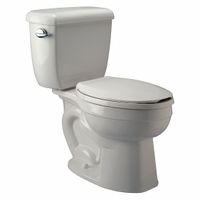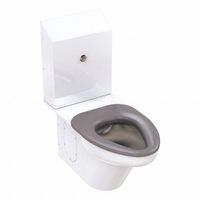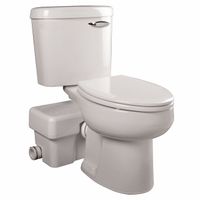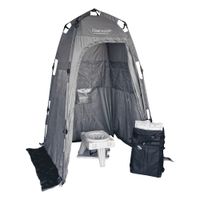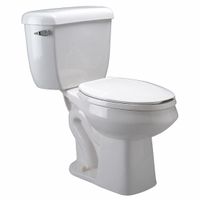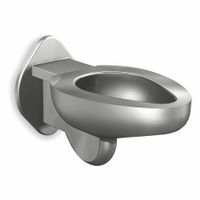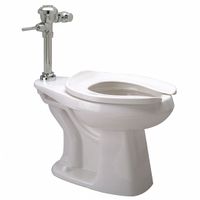Call +(254) 703 030 000 / 751 483 999 / 721 704 777
- Home
- Plumbing
- Toilets Urinals Repair Parts
- Toilets
Frequently Asked Questions
What is the difference between gravity-tank and pressure-assist toilets?
Gravity-tank toilets and pressure-assist toilets differ primarily in their flushing mechanisms and performance.
Gravity-tank toilets use the force of gravity to flush waste. When the toilet is flushed, a valve opens, allowing water from the tank to flow into the bowl. The weight of the water creates a siphoning effect, which pulls waste down the drain. These toilets are generally quieter, simpler in design, and easier to maintain. They are also more common and typically less expensive. However, they may not be as powerful in terms of flushing capability, which can sometimes lead to clogs.
Pressure-assist toilets, on the other hand, use compressed air to enhance the flushing process. Inside the tank, there is a sealed air-filled vessel. When the toilet is flushed, the pressure from the compressed air forces water into the bowl with greater force than gravity alone. This results in a more powerful and efficient flush, reducing the likelihood of clogs and improving waste removal. Pressure-assist toilets are often found in commercial settings due to their reliability and performance. However, they tend to be noisier, more expensive, and may require more complex maintenance compared to gravity-tank toilets.
In summary, gravity-tank toilets are quieter, simpler, and more cost-effective, while pressure-assist toilets offer superior flushing power and efficiency but at a higher cost and noise level.
How do tankless toilets work?
Tankless toilets operate by using a direct water supply line to flush waste, eliminating the need for a traditional water tank. When the flush mechanism is activated, either by pressing a button or a sensor, a valve opens to allow water to flow directly from the plumbing system into the toilet bowl. This high-pressure water flow is sufficient to clear waste and clean the bowl.
The key components of a tankless toilet include a flush valve, a water supply line, and a bowl designed to optimize water flow. The flush valve is typically electronically controlled, especially in commercial settings, to ensure precise water usage. In residential models, a manual button or lever may be used.
Tankless toilets often incorporate advanced flushing technologies, such as pressure-assisted or vacuum-assisted systems, to enhance performance. Pressure-assisted systems use compressed air to increase the force of the water, while vacuum-assisted systems create a vacuum to help pull waste down the drain.
These toilets are connected directly to the building's plumbing system, requiring a consistent and adequate water pressure to function effectively. This direct connection allows for a more compact design, saving space and offering a modern aesthetic.
Tankless toilets are commonly found in commercial settings due to their efficiency and durability. They are also increasingly popular in residential applications for their sleek design and water-saving capabilities. However, installation may require professional plumbing adjustments to ensure proper water pressure and drainage.
Overall, tankless toilets provide an efficient and space-saving alternative to traditional toilets, with advanced flushing mechanisms that ensure effective waste removal while conserving water.
What are the benefits of macerating toilets?
Macerating toilets offer several benefits, particularly in situations where traditional plumbing is challenging.
1. **Flexibility in Installation**: These toilets can be installed in locations where conventional plumbing is not feasible, such as basements, attics, or areas far from the main sewer line. This flexibility allows for the addition of bathrooms in unconventional spaces without extensive remodeling.
2. **Cost-Effective**: Installing a macerating toilet can be more economical than traditional systems, as it reduces the need for extensive plumbing work. This can save on labor and material costs, making it a budget-friendly option for home renovations or additions.
3. **Ease of Installation**: Macerating toilets are relatively easy to install compared to traditional systems. They require less invasive construction work, as they can connect to existing plumbing without the need for large-diameter pipes or significant structural changes.
4. **Efficient Waste Management**: These toilets use a macerator pump to grind waste into a slurry, which can then be pumped through small-diameter pipes. This process allows for efficient waste management and reduces the risk of clogs, as the waste is broken down before being transported.
5. **Space-Saving Design**: The compact design of macerating toilets makes them ideal for small spaces. They can fit into tight areas where a standard toilet might not be practical, maximizing the use of available space.
6. **Versatility**: Macerating toilets can be connected to various fixtures, such as sinks and showers, allowing for the creation of a complete bathroom setup in areas where traditional plumbing would be difficult.
7. **Minimal Disruption**: Installing a macerating toilet causes minimal disruption to the existing structure, as it does not require breaking through floors or walls to install large pipes. This makes it a convenient option for retrofitting bathrooms in older buildings.
How do portable toilets function without plumbing?
Portable toilets function without plumbing by using a self-contained system that manages waste and odors. These units are designed to be mobile and easy to maintain, making them ideal for temporary events or locations without access to traditional plumbing.
The main components of a portable toilet include a waste holding tank, a toilet seat, a ventilation system, and a door for privacy. The waste holding tank is located beneath the toilet seat and is the primary component that allows the toilet to function without plumbing. This tank is filled with a chemical solution that helps break down waste, control odors, and reduce the growth of bacteria. The chemicals typically include a combination of biocides, surfactants, and fragrances.
When a user flushes the toilet, a manual or foot-operated pump releases a small amount of water or chemical solution to rinse the bowl, directing waste into the holding tank. The ventilation system, often a simple vent pipe, helps to minimize odors by allowing gases to escape while preventing them from entering the user area.
Portable toilets are serviced regularly by sanitation companies. During servicing, the waste holding tank is emptied using a vacuum pump, and the interior is cleaned and restocked with toilet paper and hand sanitizer. The chemical solution is replenished to ensure continued odor control and waste breakdown.
Overall, portable toilets provide a convenient and hygienic solution for temporary sanitation needs without the need for plumbing infrastructure.
What features make prison toilets vandal-resistant?
Prison toilets are designed to be vandal-resistant through several key features:
1. **Material**: They are typically made from stainless steel, which is highly durable, resistant to corrosion, and difficult to break or damage. This material can withstand significant force and is less likely to be used as a weapon.
2. **Design**: The toilets have a seamless, one-piece construction with no removable parts, reducing the risk of inmates dismantling them to create weapons or tools. The design often includes rounded edges to prevent injury or self-harm.
3. **Installation**: These toilets are usually wall-mounted or floor-mounted with concealed plumbing, making it difficult for inmates to access pipes or other components that could be tampered with or used to flood cells.
4. **Security Features**: Some models include security screws and tamper-proof fasteners that require special tools to remove, preventing unauthorized disassembly.
5. **Water Efficiency**: They often have low-flow mechanisms to minimize water usage and reduce the potential for flooding. Some systems are equipped with timed flush controls to prevent repeated flushing.
6. **Anti-Ligature Design**: The toilets are designed to prevent ligature points, reducing the risk of self-harm or suicide attempts.
7. **Ease of Maintenance**: The design allows for easy cleaning and maintenance, which is crucial in a high-use environment like a prison.
8. **Integrated Units**: Some prison toilets are part of a combination unit that includes a sink, further reducing the number of fixtures and potential points of vandalism.
These features collectively ensure that prison toilets are robust, secure, and functional, minimizing the risk of vandalism and misuse in a correctional setting.
How do ligature-resistant toilets prevent tampering?
Ligature-resistant toilets are designed to prevent tampering and self-harm in environments such as psychiatric facilities, prisons, and hospitals. These toilets incorporate several features to enhance safety and security:
1. **Smooth, Rounded Surfaces**: The design includes smooth, rounded edges and surfaces to eliminate attachment points for ligatures, reducing the risk of self-harm or suicide attempts.
2. **Concealed Plumbing**: Plumbing fixtures are often concealed within the wall or floor, preventing access to pipes or other components that could be used for tampering or as ligature points.
3. **Vandal-Resistant Materials**: Constructed from durable materials like stainless steel or heavy-duty ceramics, these toilets resist breakage and tampering. The robust construction also prevents the creation of sharp edges or fragments that could be used for self-harm.
4. **Secure Installation**: Toilets are securely mounted to the floor or wall, minimizing gaps and spaces that could be exploited for hiding contraband or creating ligature points.
5. **Tamper-Proof Fasteners**: Special fasteners that require unique tools for removal are used, preventing unauthorized disassembly or tampering with the toilet.
6. **Integrated Design**: Some models feature integrated sink and toilet units, reducing the number of separate components and potential ligature points.
7. **Flush Mechanisms**: Flush controls are often designed to be tamper-proof and may be sensor-operated or require minimal force, reducing the risk of misuse or damage.
8. **Regular Inspections**: Facilities often conduct regular inspections and maintenance to ensure that toilets remain in good condition and free from potential tampering or ligature risks.
These features collectively ensure that ligature-resistant toilets provide a safer environment by minimizing opportunities for tampering and self-harm.
What are the advantages of using a commode chair?
A commode chair offers several advantages, particularly for individuals with mobility challenges or those recovering from surgery. Firstly, it provides convenience and accessibility, allowing users to have a toilet facility close to their bed or living area, reducing the need to travel to the bathroom. This is especially beneficial for individuals with limited mobility or those who experience difficulty walking.
Secondly, commode chairs enhance safety. They are designed with features such as armrests and non-slip feet, which provide stability and support, reducing the risk of falls and injuries. This is crucial for elderly users or those with balance issues.
Thirdly, commode chairs offer comfort. Many models come with padded seats and backrests, ensuring a more comfortable experience compared to standard toilets. This is important for users who may need to sit for extended periods.
Additionally, commode chairs are versatile. They can be used as standalone units or placed over existing toilets to raise the seat height, making it easier for users to sit and stand. This adaptability makes them suitable for various needs and environments.
Moreover, commode chairs are easy to clean and maintain. Most models have removable buckets or pans that can be easily emptied and sanitized, ensuring hygiene and reducing the risk of infections.
Finally, commode chairs promote independence and dignity. By providing a private and accessible toileting option, they enable users to manage their personal hygiene needs with minimal assistance, fostering a sense of autonomy and self-respect.
Overall, commode chairs are a practical solution for enhancing the quality of life for individuals with mobility issues, offering convenience, safety, comfort, versatility, and independence.
